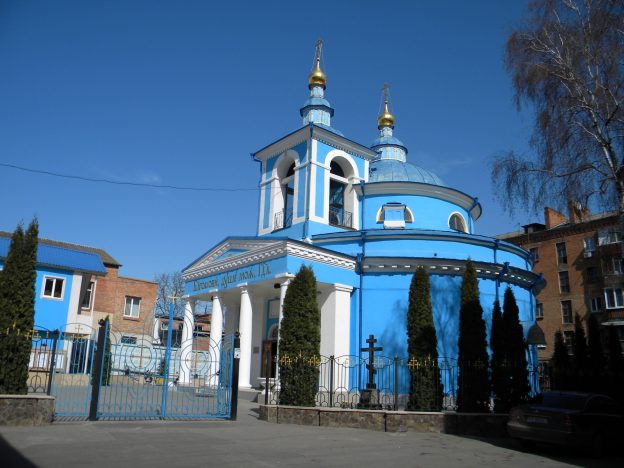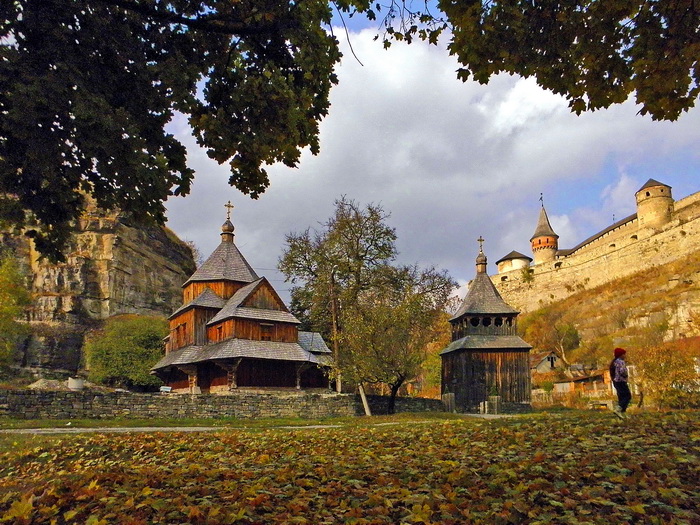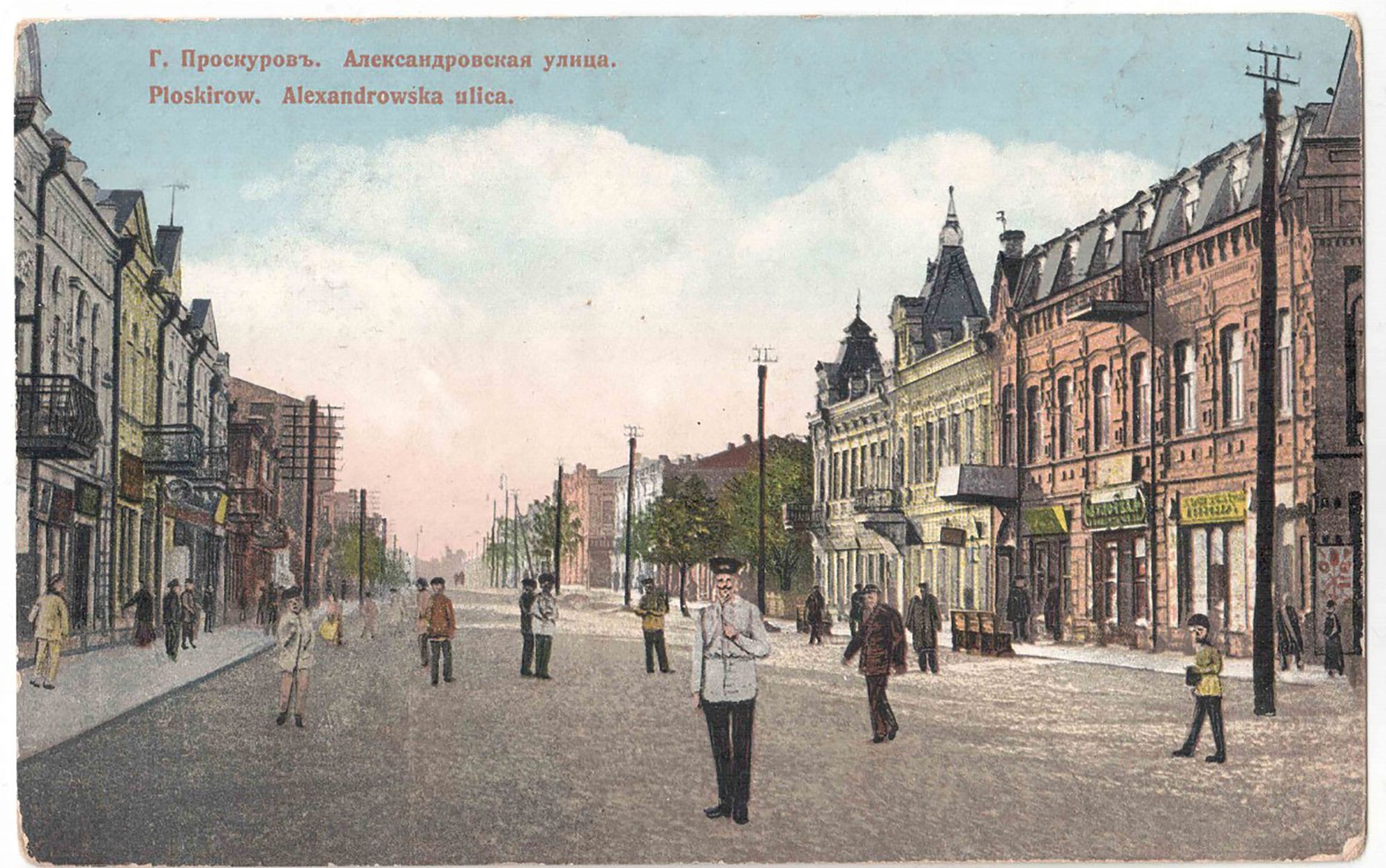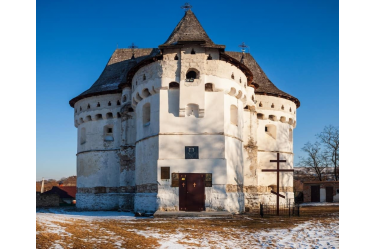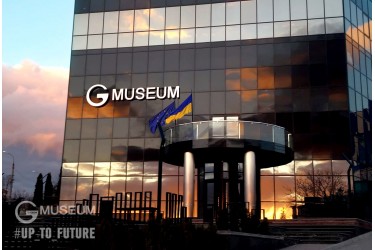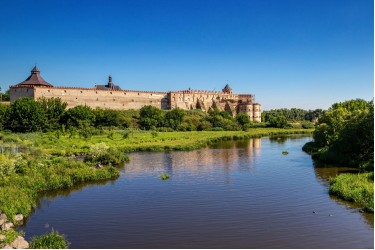5.7 km route
Start of the route: turn from Kamianetska Street (building №63).
• Heroes of the Maidan Street: → Khmelnytskyi Regional Academic Music and Drama Theatre named after Mykhailo Starytskyi → Monument to the Heavenly Hundred → Khmelnytskyi Regional Universal Scientific Library → Monument to the people of Podillia who died in Afghanistan and other local wars → Khmelnytskyi University of Management and Law Scientific Library (formerly – the house of the homeowner Vul, the headquarters of the Zaporizhzhia Corps of Ukrainian National Republic Army under the command of Petro Bolbochan) → Regional Military Commissariat (former Post and Telegraph Office).
• I. Franka Street: → moving near St. George’s Church → Khmelnytskyi City Bath №1 → Ivan Franko Park.
• Pylypchuka Street: → house №49 → Prosvita House → Khmelnytskyi District Court (house of Mykola Sikorskyi).
• Volodymyrska Street: → Spiegel Restaurant (in the past – the house of notary Isaac Spiegel) → Khmelnytskyi Regional Scientific and Methodological Centre of Culture and Art.
• Independence Square: → sculpture monument “Faith. Hope. Love”
• Soborna Street: → monument to Viacheslav Chornovil → Children’s World Shopping Centre → Cathedral of the Nativity of the Blessed Virgin.
Heroes of the Maidan Street
Heroes of the Maidan Street is located in the central part of Khmelnytskyi. It runs from Kamianetska Street to Pushkin Street.
Khmelnytskyi Regional Academic Music and Drama Theater named after Mykhailo Starytskyi
The theater in Khmelnytskyi originates from Regional Ukrainian State Drama Theater, established in Novocherkask in 1931, which was visited by Ukrainians in Krasnodar region and the North Caucasus. Its founders were a group of enthusiasts dedicated to Ukrainian theatrical art.
In the middle of 1933 the theater was moved to Vinnytsia in full strength. Since then it has become a travelling theater and was called Vinnytsia Mobile Workers and Collective Farm Theater. From Vinnytsia the theater moved to Kamianets-Podilskyi, which was then the regional centre. And from there it moved to Proskuriv, which became the centre of the region in 1941.
The repertoire was dominated by Ukrainian classics and since the 1950s there have appeared plays by Western playwrights – Carlo Goldoni, Bertolt Brecht, Federico Garcia Lorca, William Shakespeare.
Every day the music and drama theater becomes closer to audience, expands genres and forms, attracts visitors to the performances discussions.
Monument to the Heavenly Hundred Heroes
A bronze monument weighing one ton is depicted as a dove sitting on the severed head of a crow. The composition symbolizes the victory of good over evil. The faces of those killed during the Revolution of Dignity are carved on the pigeon’s wings. On the reverse side of the sculpture there is an inscription: “Ukraine – above all!”. The bronze dove reaches six and a half meters in height. From afar, the monument resembles a candle as a sign of mourning for the dead.
The authors of the work are well-known artists and sculptors from Khmelnytskyi Roman Albul, Bohdan Mazur and Mykola Mazur.
Khmelnytskyi Regional Universal Scientific Library
The library began its revival after Proskuriv liberation on April 1, 1944. The premises of the library were expanded – it was moved to the former premises of the city treasury (on the corner of modern Heroes of the Maidan and Hrushevskoho streets), where it is now.
Monument to the people of Podillia who died in Afghanistan and other local wars
The memorial is dedicated to the people of Podillia who died in Afghanistan and other local wars. A granite hemisphere representing a globe is installed on a cylindrical pedestal, made of red marble. On it a huge hand rearranges the figure of a warrior ready to rush into battle as if playing chess. The sculptural composition is made of bronze, consists of a life-size figure of a soldier who had taken an oath and must carry out an order; and of the ruler hand of the surreal dimensions.
There is an inscription engraved on the monument: The rulers make mistakes – people suffer.
The authors of the monument are Ukrainian folk artists, father and son, Mykola Mazur and Bohdan Mazur. The monument was unveiled in September 2002.
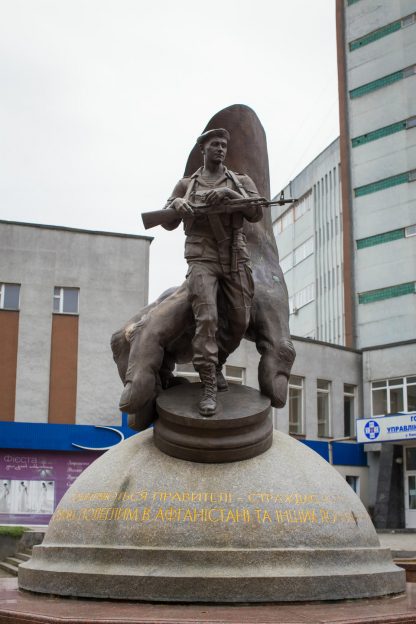
Khmelnytskyi University of Management and Law Scientific Library
This house was built in 1914 by homeowner Vul for the needs of the city bank. At the beginning of the First World War, the bank building was temporarily transferred to the military department. In 1917-20, the headquarters of the Zaporizhzhia Corps of Ukrainian National Republic (UNR) Army was located here, which was commanded by a prominent Ukrainian military leader, Colonel of UNR Army Petro Bolbochan. In Soviet times, the building housed the main post office, telephone exchange, and since 2006 – Khmelnytskyi University of Management and Law library.
Regional Military Commissariat (former Post and Telegraph Office)
The building was erected in the early twentieth century for Proskuriv Post and Telegraph Office. Proskuriv Post and Telegraph Office was located here until the early 1920s. In Soviet times the building was owned by government agencies. The building is two-story, brick and painted. The rich decor of the main facade is decorated with brickwork, the elements of which are borrowed from different styles, which can be traced to Neo-Renaissance and national-romantic features. In general, the building resembles a small palace, the details of which are emphasized by painting.
Ivana Franka Street
The street runs through the city central part – from Podilska Street to the former first military town of the Dubove residential area.
St. George’s Church
Now it is a functioning church, an architectural monument of Khmelnytskyi, located in close proximity to the city historic centre. The Church of the Holy Apostles Peter and Paul was founded in 1775 as a regimental church, which always and everywhere accompanied the 46th Dnipro Infantry Regiment, and did not leave it even during the war with Napoleon in 1812. When the regiment settled in Proskuriv, it was decided to have a building for the church. A collection of donations was announced, and in 1898 the St. George’s Church was built at the expense of the parishioners. A little later, in 1906, a bell tower was completed near the church. Interestingly, insides of the temple was not painted by artists but by skilled soldiers.
In Soviet times the church building fell into disrepair. Its restoration began in 1996, and now it is named after St. George the Victorious.
Khmelnytskyi City Bath № 1 or the First City Bath
In the middle of the 19th century Proskuriv public bath was located in a small house in the neighborhoods. The bather in tubs brought water from the river on a cart and heated it in a metal boiler. The bath worked only in the cold season, in the summer people bathed in the river, in the so-called “baths”. The bath complex, which also included a boiler room and a mechanical laundry, was finally put into operation in 1932. The new communal company was named “Garrison and Civil Communal Bath named after the 12th anniversary of October”. It has become the largest in the region and the mechanical laundry was the only one in the whole region. The bath could accommodate 2,200 people a day.
Khmelnytskyi City Bath №1, which has not been operating since 2013 due to emergency condition, reopened its doors in 2017.
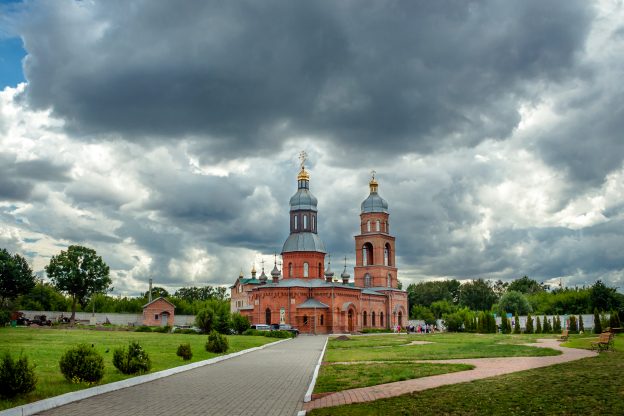
Pylypchuka Street
The street was laid out according to the city development plan from 1888, the first name was given from the direction to the railway station – Mala Vokzalna Street. The street did not reach the station and ended, resting on a huge wasteland, so it is not surprising that, having such a “dead end”, Mala Vokzalna Street among the people was called Deaf Street. Along the street were allotted areas, which in the late XIX – early XX century, representatives of the Proskuriv middle class actively took for construction. In the first years of Soviet rule, the street was renamed Robsilmilitsii. This name was difficult to get used to, and therefore in 1946 still officially approved the “folk” name – Deaf Street. In the 1960s, the street was named after Zhdanov, and in 1989 the street was renamed in honor of Volodymyr Pylypchuk.
Prosvita House
Prosvita Khmelnytskyi Regional Association named after Taras Shevchenko is a chamber with invisible energy of love in embroidered rushnyks on icons, it is a reading room where rare editions are collected, which no other library in Khmelnytskyi has. And it is, without exaggeration, the spiritual treasure of Khmelnytskyi!
Prosvita People’s House is located in one-story building on Pylypchuka Street, built in 1898. By the way, Pylypchuka Street is one of the oldest streets in Khmelnytskyi! In addition to Prosvita House, you will be able to see a whole ensemble of modernist style buildings, as well as get acquainted with a memorial sign, which is based on the fragments of a real rocket!
The monument was erected in 2002, in honor of the signing an agreement with the mayor of Khmelnytskyi sister city in the USA – Modesto.
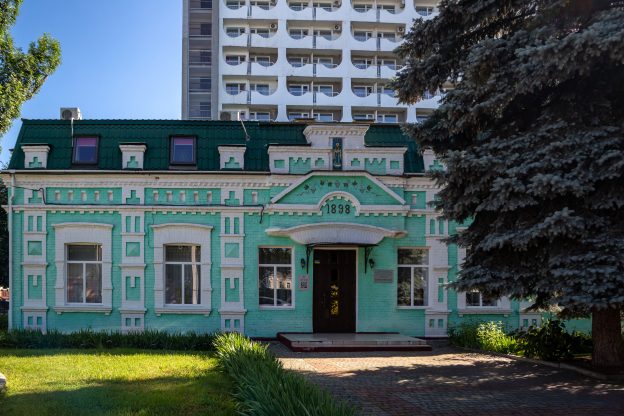
Khmelnytskyi District Court or the house of the last Proskuriv chairman
It was built in 1897 as an apartment house. The householder rented the first floor to a Jewish school, and the second “for apartments”. One of the tenants was Mykola Vikentiiovych Sikora (1862–1921) – respected in the city at the beginning of the XX century man, who had become the last Proskuriv mayor in the pre-Soviet history.
Volodymyrska Street
It is a street in Khmelnytskyi, which runs through the central part of the city from Kamianetska Street to Staromiska Street.
Soborna, Hrushevskoho, Teatralna, Proskurivska, Podilska, Volodymyra Pylypchuka and Vaisera streets join Volodymyrska Street.
Mansion of Isaac Spiegel
The mansion of the notary Isaac Spiegel was the first brick building in the central part of Proskuriv at that time. For a long time Isaac lived in the Jewish quarters near the Southern Buh River. Gradually becoming rich, Spiegel made his old dream come true and in the early 1900s built a solid brick house in the prestigious central part of the city along Dvorianska Street. The mansion is made in modernist architectural style. Nowadays the house has retained the curvilinear shapes of doors and window frames, a forged pattern, which is located on the balcony fence. Plant motifs were used for windows and balconies decoration. In Soviet times it housed the regional book trade, and now Spiegel Restaurant is located here, where you can enjoy cuisine of Podillia according to old recipes, interpreted in a new way.
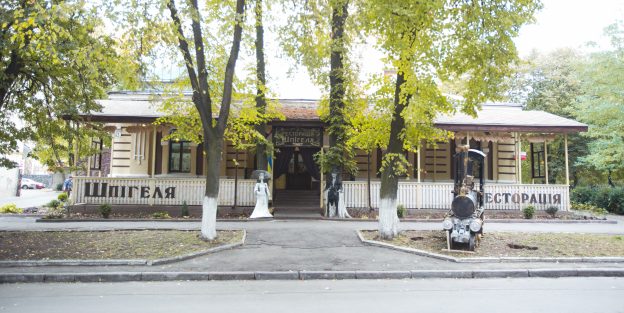
Khmelnytskyi Regional Scientific and Methodological Centre of Culture and Art
The house was built in 1907 as a private mansion, since 1937 it housed the Palace of Pioneers (moved to the main street in the 1950s). And since 1973 a puppet theater was in the building. In 1989 the regional puppet theater moved to the building №46 on Proskurivska Street and Regional Scientific and Methodical Centre of Culture and Art is located in the building №103 on Volodymyrska Street.
Independence Square
Modern Independence Square in Khmelnytskyi as a city square was formed in the mid-1950s during House of Councils construction (now – the building of Khmelnytskyi Regional State Administration). Until 1991 the square was called Lenin Square, but after the proclamation of Ukraine as an independent state, it became Independence Square.
Sculpture Monument “Faith. Hope. Love”
Monumental and sculptural composition “Faith. Hope. Love” was established for the City Day on September 24, 2011 in front of the regional state administration. The composition is based on the figures of three ancient Ukrainian guardians. The triad is placed on a large circle, which symbolizes the eternal, inseparable circle of existence and the succession of generations. In the same circle – the figures of storks; catkins of viburnum, bunches of grapes – symbols of fertility and unity; rushnyks with which Ukrainian mothers have always blessed their children. On the reverse side of the composition there is a kobzar with a kobza – an expression of thoughts and hopes of Ukrainian people. The author of the work is the People’s Artist of Ukraine Mykola Mazur.
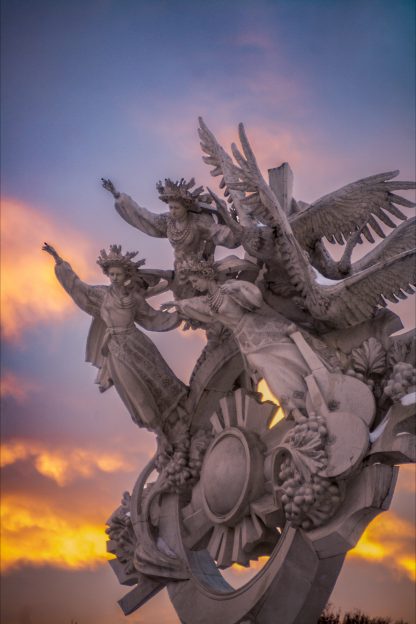
Soborna Street
It is a street in Khmelnytskyi, which runs through the central part of the city from Prybuzka Street to Independence Square.
Volodymyrska, Heroiv Maidanu, Proskurivskoho Pidpillia, Podilska, Vaisera, Staromiska and Buzka streets join Soborna Street.
The street was laid out according to the city development plan from 1824, it started from the square with the Cathedral of the Nativity of the Mother of God, from which it got its name.
The monument to Viacheslav Chornovil
A monument to Viacheslav Chornovil, a prominent Ukrainian politician and public figure of the present time, was unveiled in December 2007. The authors are Ukrainian artists, father and son, Mykola Mazur and Bohdan Mazur.
Children’s World and a fountain with storks
At the beginning of Proskurivska Street in the 1950s a department store was built, which at the end of the 20th century was known as Children’s World. A park was laid out near the department store for the territory arrangement. In 1956 a fountain was built on the park territory, the main architectural elements of which were frogs and storks. The fountain in the public garden in the city centre has become one of the cultural recreation places for Khmelnytskyi residents. As of 2013 restoration work was carried out to improve the facility condition – before that it had not worked for a number of years. In 2013 the fountain with storks and frogs was transferred to the balance of the city enterprise for the communal property non-residential premises maintenance.
Cathedral of the Nativity of the Blessed Virgin
Cathedral of the Nativity of the Blessed Virgin is the oldest building in Khmelnytskyi. The shrine appeared in 1837. The native residents of Proskuriv from generation to generation say that there was a wooden church earlier on the site of the cathedral, which was destroyed by fatal city fire in 1822.
In Soviet times Cathedral of the Nativity of the Blessed Virgin Mary was closed many times and reopened for a short time. The building was transferred to the machine-tractor station, warehouse or archive. In the 1980s it was converted first into museum of religion, then museum of Khmelnitskyi, planetarium and even … Vertical motorcycle-ride attraction. But all of these projects have failed. There was even an attempt to make an entertainment place in the temple. This is now reminiscent of the inner balcony, which surrounds the church premises.
Only in 1989, after a major overhaul, Cathedral of the Nativity of the Blessed Virgin reopened its doors to believers.
